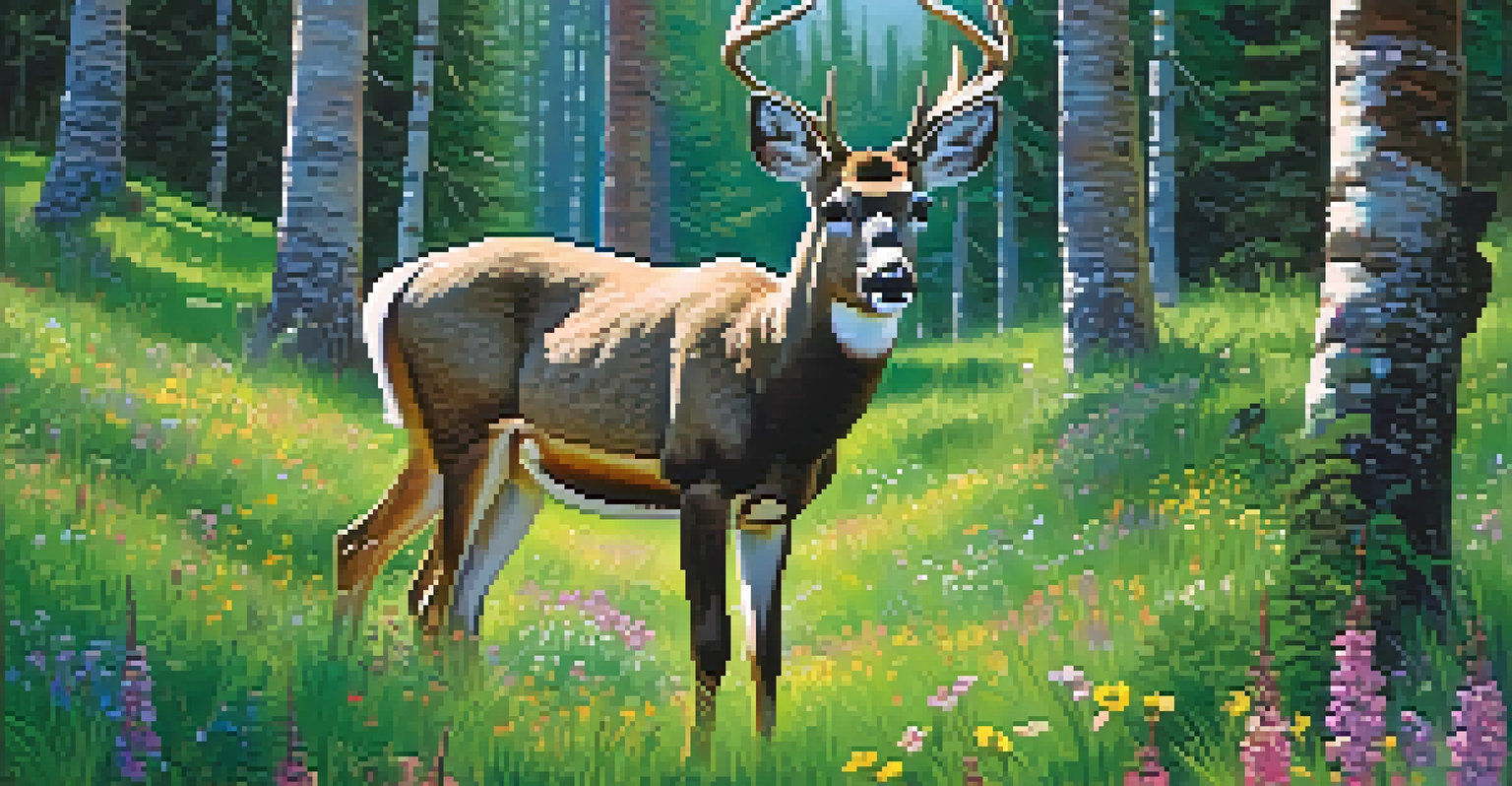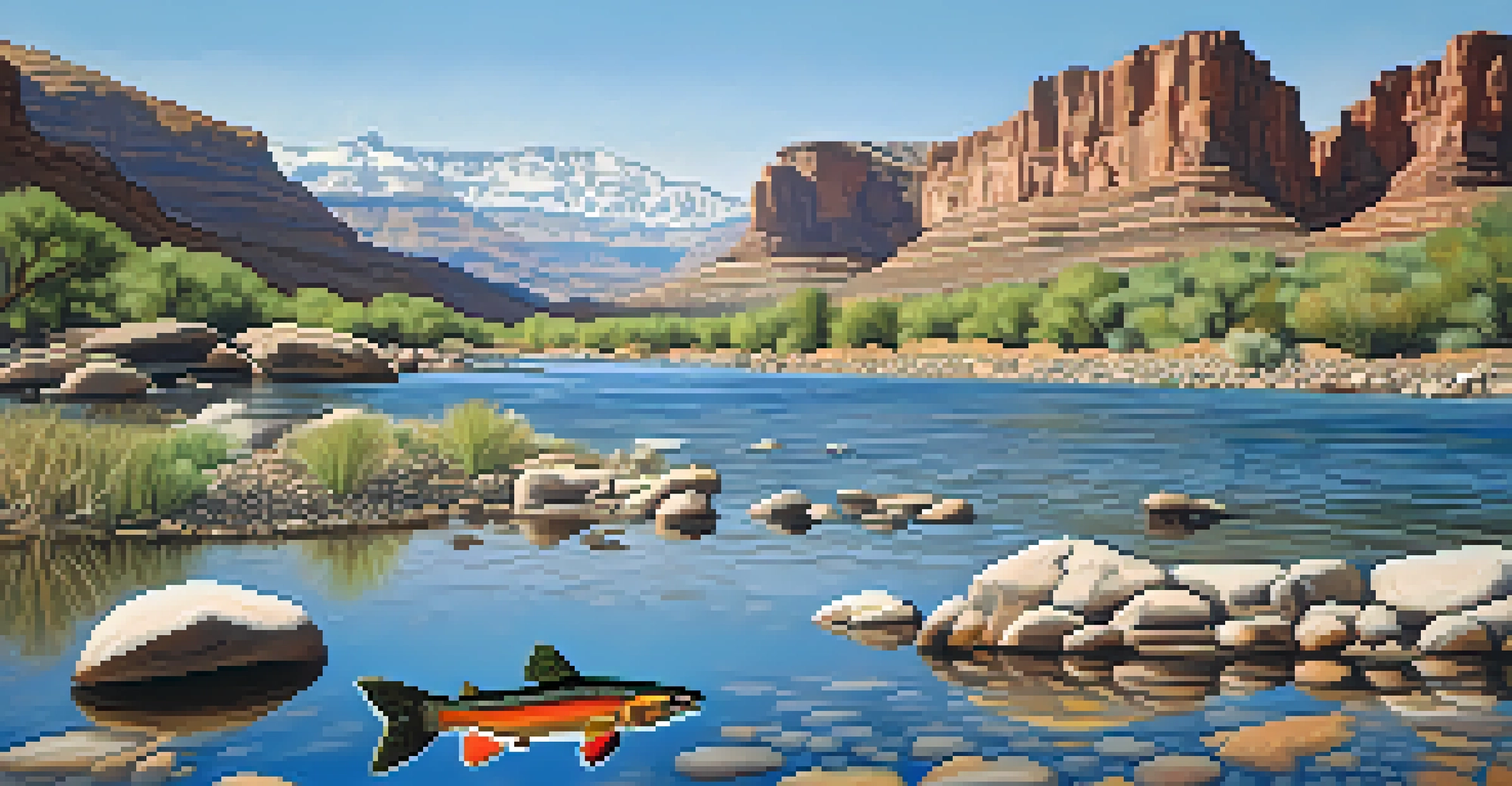Impact of Climate Change on Utah's Wildlife and Ecosystems

How Climate Change Affects Utah's Unique Habitats
Utah is home to diverse ecosystems, from arid deserts to lush forests. However, climate change threatens these habitats by altering temperature and precipitation patterns. As temperatures rise, many species struggle to adapt to their changing environments, leading to habitat loss and fragmentation.
What we are doing to the forests of the world is but a mirror reflection of what we are doing to ourselves and to one another.
For example, the Great Salt Lake, a vital habitat for migratory birds, is shrinking due to decreased snowpack and increased evaporation. This has dire consequences for avian species that rely on the lake for food and nesting. With less habitat available, birds may face increased competition and reduced populations.
Moreover, higher temperatures can lead to more frequent wildfires, especially in Utah's mountainous regions. These fires can devastate entire ecosystems, making recovery more challenging for plants and animals already stressed by climate change.
Impacts on Utah's Wildlife Populations
Wildlife in Utah faces various challenges due to climate change, including shifting migration patterns and altered breeding seasons. For instance, some species, like the mule deer, may find their food sources diminished as plants bloom earlier in warmer temperatures. This mismatch can lead to malnutrition and decreased reproduction rates.

Additionally, amphibians, such as the boreal toad, are particularly vulnerable to changing climates. These creatures rely on moist environments, and as Utah's climate becomes drier, their habitats are threatened. The decline of these species can disrupt the entire food web, affecting predators and prey alike.
Climate Change Threatens Habitats
Utah's diverse ecosystems are increasingly at risk due to rising temperatures and altered precipitation patterns.
Predators, too, are feeling the strain. As their prey adapt to changing conditions, animals like the mountain lion may find it difficult to hunt effectively. This imbalance further exacerbates the challenges faced by wildlife in Utah, highlighting the interconnectedness of ecosystems.
The Role of Water Resources in Ecosystem Health
Water is a critical resource for all living organisms, and its availability is increasingly threatened by climate change. In Utah, prolonged droughts and reduced snowpack are leading to lower water levels in rivers and lakes. This scarcity impacts not only aquatic species but also terrestrial animals that depend on these water sources.
The environment is where we all meet; where we all have a mutual interest; it is the one thing all of us share.
For example, fish populations in Utah's rivers may decline as water temperatures rise and flow decreases. Species such as the native cutthroat trout are particularly sensitive to temperature changes, making them susceptible to extinction if conditions worsen. Protecting these aquatic habitats is essential for maintaining biodiversity.
Moreover, as water resources dwindle, competition for this precious commodity intensifies among wildlife. Animals may be forced to migrate further in search of water, leading to increased stress and potential conflicts with human activities. This highlights the need for sustainable water management practices in the face of climate change.
The Effects of Invasive Species on Ecosystems
Climate change can exacerbate the spread of invasive species that threaten Utah's native ecosystems. Higher temperatures and altered rainfall patterns can create favorable conditions for these non-native species, allowing them to outcompete local flora and fauna. This shift can lead to reduced biodiversity and altered ecosystem functions.
One example is the tamarisk tree, which has invaded riparian areas in Utah, displacing native plants and altering water availability. As these invasive species establish themselves, they can affect the entire food web, impacting insects, birds, and larger mammals that rely on native plants for sustenance.
Wildlife Populations Are Declining
Many species in Utah are facing challenges like shifting migration patterns and diminished food sources due to climate change.
Controlling invasive species is crucial for preserving Utah's unique ecosystems. Restoration efforts often require significant resources and time, but they are essential for maintaining the health and resilience of these environments against the backdrop of climate change.
The Impact of Climate Change on Endangered Species
Utah is home to several endangered species that are particularly vulnerable to climate change. As their habitats shift and degrade, these species face an uphill battle for survival. For instance, the California condor, once on the brink of extinction, is threatened by changing ecosystems that disrupt their feeding and nesting behaviors.
Moreover, the desert tortoise, which relies on specific plant communities for food, is also feeling the pressure. As climate change alters these plant communities, the tortoise may struggle to find adequate nutrition, further jeopardizing its survival. Conservation efforts must adapt to these changes to protect these species effectively.
Understanding the unique needs of endangered species in the context of climate change is crucial. This includes habitat restoration and protection, as well as monitoring populations to ensure that conservation strategies remain effective in an ever-changing environment.
Community Efforts in Conservation and Adaptation
In response to the challenges posed by climate change, communities across Utah are coming together to protect wildlife and ecosystems. Local organizations, government agencies, and volunteers are working collaboratively to implement conservation initiatives that address climate impacts. These efforts include habitat restoration projects and wildlife corridors to facilitate animal movement.
For example, the Great Salt Lake Audubon Society engages the community in bird monitoring and habitat restoration efforts. By educating residents about the importance of local ecosystems, they foster a sense of stewardship that can make a real difference in conservation outcomes. Community involvement is essential for building resilience against climate change.
Community Conservation Efforts Grow
Local organizations and residents are collaborating to implement conservation initiatives that address the impacts of climate change on wildlife and ecosystems.
Furthermore, public awareness campaigns highlight the significance of sustainable practices. By promoting responsible water use and supporting local conservation efforts, individuals can contribute to the protection of Utah's wildlife and ecosystems. Collective action at the community level is vital for ensuring a sustainable future.
The Importance of Climate Change Education
Education plays a pivotal role in addressing the impacts of climate change on wildlife and ecosystems. By raising awareness about the challenges faced by Utah's natural environments, individuals can become more informed advocates for conservation. Schools, nonprofits, and community organizations can all play a part in this educational effort.
For instance, educational programs that focus on local ecosystems can inspire youth to take an interest in wildlife conservation. By engaging students with hands-on activities like habitat restoration or wildlife monitoring, we can foster a new generation of environmentally-conscious citizens. This proactive approach ensures that conservation efforts continue into the future.

Moreover, understanding the science behind climate change equips individuals with the knowledge to make informed choices. Whether it's reducing carbon footprints or supporting local conservation initiatives, education empowers communities to take meaningful action. A well-informed public is essential for driving positive change in the face of climate challenges.